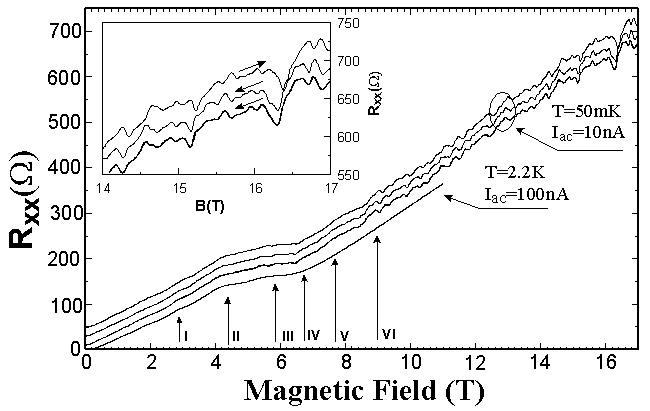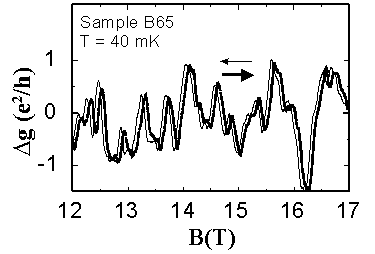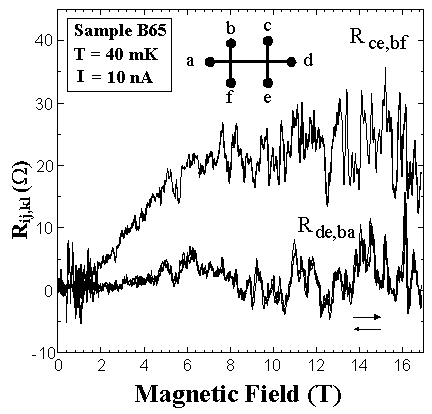
Wide parabolic quantum wells (WPQW) can be used to study a continuous transition from a 2D- to a 3D - electron system. The use of Lead Telluride (PbTe) allows volume doping of the electron channel in order to achieve a flat potential in the channel and getting still a sufficiently high mobility of the electrons. In our case the bulk density in the electron channel is typically in the range of 1...3x10^17cm^-3 and the effective width of the electron channel ranges from 300 to 600nm. This results in a sheet density which is more than an order of magnitude larger than the largest sheet density which has been realized in GaAs/AlGaAs WPQW’s up to now.
The experiments have been performed in a super conducting magnet in fields up to 17 Tesla with a dilution refrigerator for temperatures down to 40mK. A standard lock-in technique was used (f = 13.7 Hz) and the constant ac-current was chosen to be 10nA. At lower fields the magneto transport data (Fig.1) exhibit Shubnikov de Haas (SdH) oscillations (labelled I, II and III) which can be explained very well by the bulk properties of the electron channel. In the upper field range additional structures can be found at low temperatures: There are smooth structures (marked IV, V and VI), which are covered with perfect reproducible fluctuations. The smooth structures can be attributed to the 2D-subband structure [1].

Fig.1: Typical magnetotransport data. Insert: Magnified upper field range..

Fig2. Conduction fluctuations extracted from Rxx
The conductance fluctuations (Fig.2), which can be extracted from Rxx appear to be in the order of e^2/h. Since definitely universal conductance fluctuations from the bulk can be ruled out because of the macroscopic sample size (Hall bar width w = 100 micron, length L = 200 micron), a possible contribution of edge channels has been checked by non-local magneto transport measurements. Indeed, this experiments exhibit a strong non-local signal although the voltage probes are 200 micron remote from the classical current path (Fig.3) [2].

Fig.3: Non-local data for two different contact configurations, first pair of indices denotes the current contact, the second pair the voltage probes.
This means that there is a well pronounced edge state conduction although a well defined 3D-behaviour was demonstrated at the same time. The co-existence of edge state and dissipative bulk conduction [3] leads to a novel situation in which the quantum Hall effect cannot show up although dissipation less edge state conduction over macroscopic distances is possible. This behaviour can be understood in terms of the many valley character of PbTe in which we get two electron systems sitting in different valleys. One builds a 3D-system while the other one realizes a 2D-system of sufficiently separated 2D-subbands (approx. 1 meV). It is special for WPQW’s that even if the Fermi level is already down in the lowest Landau level there are still a number of subbands occupied. This subbands can form into edge states at high magnetic fields.
[1] J. Oswald, G. Heigl, M. Pippan, G. Span, T. Stellberger, D.K.Maude, J.C.Portal., Proc. of EP2DS XI, Nottingham 1995, Surface Science 361/362, 525 (1996)
2] J.Oswald, G.Heigl, G.Span, P.Ganitzer, A.Homer, D.K.Maude, J.C.Portal, Proc. 3rd Int. Symp. On "New Penomena in Mesoscopic Structures", Physica B, in print
[3] J. Oswald, G.Heigl, G.Span, D.K.Maude, J.C.Portal submitted to Phys. Rev. B